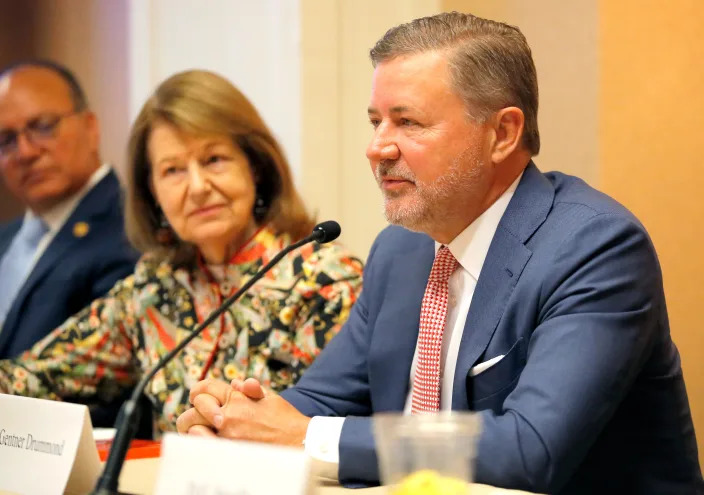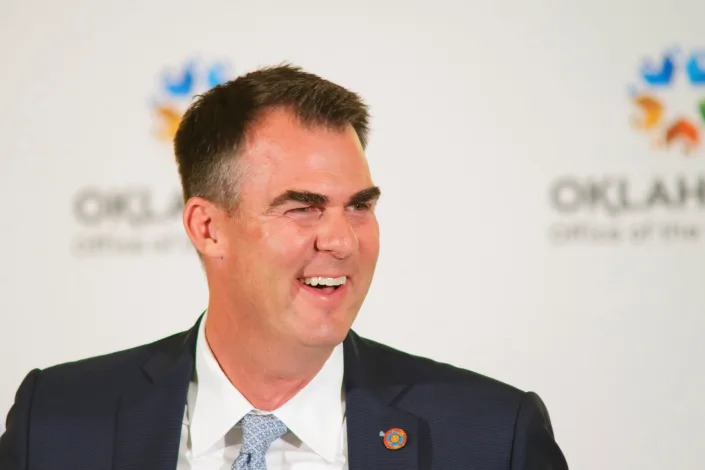
Michael Conroy/AP Photo
Josh Siegel, Kelsey Tamborrino and Jessie Blaeser
Sun, August 13, 2023
President Joe Biden’s year-old climate law triggered a deluge of clean energy spending in almost every state — and it’s splitting conservatives across rural America.
Some communities are welcoming their slice of the $370 billion pot of federal tax incentives meant to accelerate the development of renewable energy and the deployment of electric vehicles as a way to bring back jobs. Others see the Inflation Reduction Act as a vehicle for boosting Chinese businesses and the reach of their government.
While Republicans on the campaign trail and in Congress regularly bash the law — which Biden signed a year ago Wednesday — as big-government overreach by Democrats bent on killing off fossil fuels, its benefits are disproportionately landing in their communities. And as the measure supercharges efforts to combat climate change, it’s also rekindling economies where people have felt forgotten, potentially softening how some voters view Biden as he seeks reelection.
“We always knew that it would fall across America, not in one particular state or another,” Senate Majority Leader Chuck Schumer said in an interview. “We know that rural areas have been neglected, we know that rural areas have fallen behind, and we wanted to help those rural areas. And if some of those rural areas are red, so be it.”
For the companies that are hoping to reap federal tax incentives as well as state and local sweeteners, Republican parts of the country often look more attractive. Of the 200 project locations that have been announced through July, more than 60 percent are in GOP-held districts, according to a POLITICO analysis.
“Companies are building projects where they will be the most effective and generate the most resources,” said Jason Grumet, CEO of the American Clean Power Association, a clean energy industry trade group. “It is no surprise in the Southeast, Upper Midwest, where you have significant amounts of manufacturing capacity, much of which has been idled and left the country.”
As the IRA hits its first anniversary, POLITICO traveled across the nation to examine how the law is playing out in Oklahoma (where the Republican governor is claiming credit for the state’s booming clean energy sector), Michigan (where multibillion-dollar battery projects will generate jobs but are provoking uproars over Chinese ties) and upstate New York (where Republican congressmembers in Biden districts are trying to navigate the politics of the IRA).
MICHIGAN: Green Charter Township and Marshall
Jim Chapman, the Republican supervisor for Green Charter Township, a small rural community an hour’s drive north of Grand Rapids, said he’s received several death threats over a planned $2.36 billion battery component manufacturing facility in the area.
“I accepted the fact that I was going to have to be the lightning rod,” Chapman said in an interview from his office. He is facing a recall effort launched by residents worried about the plant’s sponsor, Gotion, and its links to China.
“Where you have people that are concerned about the Chinese Communist [Party] — they don’t know how to [fight] it in Lansing. They don’t know how to deal with it in Washington. They can deal with it locally,” he said.
Gotion Inc., which recently finalized the purchase of 270 acres in Green Charter Township, is a U.S. subsidiary of Gotion High-tech Co., an international company founded in China.
Residents and some elected officials point to Gotion High-tech documents that include language to “carry out Party activities” in accordance with the Chinese Communist Party.
Chuck Thelen, the vice president of North American manufacturing at Gotion, has insisted there is no such language in the U.S.-based company’s articles of incorporation. Thelen said the Chinese Communist Party has no presence in the North American company.
“The rumors that you’ve heard about us bringing communism to North America are just flat-out fear-mongering and really have nothing based in reality,” he said.
The plant’s backers say the opposition represents just a small minority of residents and argue it will bring much-needed economic growth.
“We desperately need good-paying jobs,” said Carlleen Rose, 69, a local business owner.
But those who oppose the project have a lengthy list of concerns, including a lack of transparency in the process up to this point and potential for air and water pollution stemming from battery materials.
Thelen said the company is currently going through the permitting process for the facility, including the next phase of an environmental study.
“All you gotta do is drive around the community and you’ll see how many people are against it,” said Lori Brock, 58, the owner of a local real estate agency and a horse farm across from the planned site.
“They’re pushing it down our throats,” Brock added. “Why are we giving our tax money to China when we’re almost at war with China? Why aren’t we giving our tax money to an American company?”
That antipathy is shared by local elected officials, including Republican Rep. John Moolenaar, who represents the district.
“Gotion North America is a subsidiary of a company that pledges allegiance to the CCP and I don’t think they should be receiving taxpayer money to build in Michigan,” he said in an interview.
The site’s proximity to a military training center has also raised national security concerns, although the Committee on Foreign Investment in the United States reportedly determined earlier this year the factory was outside of its jurisdiction.
The project — along with a separate Ford Motor Co. battery facility in Marshall, Mich., that will license technology from a Chinese company — mark a recurring theme of distrust that undergirds some of the manufacturing announcements that are flowing to red districts.
More than 40 percent of the new manufacturing announcements made since the IRA was enacted were led by companies based outside the U.S. or by companies outside the U.S. in partnership with a U.S. company, according to data shared with POLITICO by national business group E2. At least six of those announcements were made by, or in partnership with, a Chinese-based company.
Ford’s planned $3.5 billion BlueOval Battery Park Michigan project two hours south of the Gotion plant is expected to create 2,500 new U.S. jobs.
But its reliance on technology from China-based Contemporary Amperex Technology Co. Ltd., a large global battery producer, has drawn pushback both locally and in Washington, where Republicans are putting the project under a microscope. Residents have also lodged concerns about the plant's effects on the environment, particularly to the Kalamazoo River, and the loss of farmland.
Ford spokesperson Melissa Miller said there’s “a lot of misinformation” about the Marshall project. Ford, she said in a statement, will own and control the plant with “zero foreign investment” and its Chinese partner’s involvement will be as a licensor of battery cell technology and a service provider on a contractual basis.
“CATL does not and will not have any equity in the plant and will receive zero tax dollars,” Miller said.
On the environmental concerns, she said the company is still designing the plant, but has begun identifying and mitigating potential failures.
Residents in both communities have packed into town meetings over the months and launched Facebook pages devoted to their opposition. The two projects have prompted recall efforts for local officials and in the case of the Marshall project, a citizen-led lawsuit.
“America’s gotta wake up. We’re being taken over,” Debbie Dygert, 71, said in an interview after a recent Green Charter Township board meeting, which devolved into shouting over concerns of China’s influence and claims by some of xenophobia.
Both the Ford and Gotion facilities were applauded by Gov. Gretchen Whitmer, a Democrat, and are taking advantage of hundreds of millions of dollars in state-level incentives, on top of the likely incentives under the IRA.
Quentin Messer, Jr., the CEO of the Michigan Economic Development Corporation, a quasi-state agency, called it “critically important” for Michigan to maintain a foothold in battery manufacturing.
“You always have to make the affirmative case as to why growth and progress are going to be beneficial, and not something to be feared,” Messer said. “And I think that’s something that we understand we have to do and make more explicit to folks.”
OKLAHOMA: Inola and Oklahoma City
Bill McAnally, a self-declared “Trump fan,” was ecstatic when an Italian company, Enel, announced plans in May to spend more than $1 billion — the largest private investment in the state’s history — to build a solar cell and panel manufacturing facility a half-hour drive east of Tulsa.
He owns a diner that is one of the few restaurants around Inola, a town home to 1,500 people, and stands to see sales jump from the influx of new customers.
“It’s a great deal,” said McAnally, 68, since Enel, through its affiliate 3Sun USA, expects to generate 1,000 manufacturing jobs in 2025. “All it does is help my business.”
But when told by a reporter that Enel plans to take advantage of tax credits included in Biden’s climate law, McAnally abruptly changed his tune.
“I don’t support it now,” he said. “The federal government doesn’t need to get involved. We all support bringing in green, but we don’t want to give them all this free money.”
But Oklahoma’s Republican governor, Kevin Stitt, has no qualms about the IRA incentives that are attracting multinational companies to his state.
“Obviously some of these incentives from the federal government are causing people to look into the U.S. market,” Stitt said in an interview in the state capitol.
In addition to Enel, electric vehicle startup Canoo announced plans in November to manufacture cars in Oklahoma City, where it says it will employ 500 people, as well as battery modules in Pryor.
But Stitt also personally takes credit for attracting clean energy manufacturing, a sector he said dovetails with Oklahoma’s oil and gas industry, low energy costs, ample transportation infrastructure and central location in the country. The state also draws about 40 percent of its power from wind and is home to more electric vehicle fast-charging stations per capita than any other state.
“We’re just trying to be smart,” Stitt said. “All the [research and development] dollars are flowing into electric vehicles. Batteries. So then I’m thinking, let’s go where the puck is headed. Oklahoma doesn’t want to get left behind. We want the jobs.”
At Stitt’s behest, the Legislature approved taxpayer-funded rebates to companies that build facilities and create jobs in the state, including a $180 million incentive package to help lure Enel. It offered $300 million in incentives to Canoo, though the California-based company saw that figure drop after it missed construction targets.
But some in the state’s all-Republican congressional delegation are resisting the push — including Rep. Josh Brecheen, a freshman member of the conservative House Freedom Caucus who represents the district where Enel is building its huge solar project.
“Do I want jobs to come to Oklahoma? Yes. Do I want companies to stand on their own and be on an even playing field without taxpayer subsidization? Absolutely,” Brecheen said in an interview where he ridiculed wind and solar energy as “unreliable.”
Rep. Kevin Hern, who represents the larger Tulsa area surrounding the Enel project site, has helped lead GOP efforts to undo Biden’s climate law as chair of the Republican Study Committee, which released a proposal in June to repeal the IRA.
But Stitt doesn’t support repealing the law because companies have already factored in the incentives.
“I would never want to change the rules on someone mid-game,” he said.
Ron Burrows, one of three Republican commissioners for Rogers County, home to a river port in Inola that is set to host the plant, said local political leaders were important in sealing Enel’s decision to locate in Oklahoma.
“Local government is the last welcome mat before they enter the door, and my role is to give them some peace of mind that I’m supportive and not adversarial,” Burrows said.
GOP lawmakers, he said, need to take into account how their actions affect the districts they serve.
“You got to weigh what your belief system is versus what in reality is happening in the community,” Burrows said. “If things get passed outside of what [they] believe in, then [they have] to trust in us to spend that money to the best of our ability and we will grow these rural populations.”
NEW YORK: Kingston
The Hudson Valley has been waiting for an industrial reboot for almost 30 years. And now that Biden’s climate law is offering some flicker of hope, some Republicans are lining up to claim some bit of credit.
With the lucrative IRA incentives on offer, Canadian company Zinc8 Energy Solutions is planning to use a former IBM computer factory to make batteries for EVs and ones that can bolster electric grids, although it hasn’t finalized the site yet.
Having seen the economic engine of the region empty out 7,000 jobs a generation ago, both Democrats and Republicans support bringing the new project to Ulster County.
GOP Rep. Marc Molinaro, who represents the county, acknowledged the federal program is an “exceptionally important tool” in helping draw Zinc8 — despite his joining most Republicans in voting for legislation that would’ve repealed many of the climate law’s clean energy incentives.
In an interview, Molinaro, who is one of Democrats’ top targets in 2024, minimized the importance of his vote, saying the measure was mostly a messaging bill ahead of the debt ceiling fight with Democrats this spring. He insists he would fight to keep the IRA clean energy subsidies intact in the future and that enough Republicans agree.
“When you grow up living along the Hudson River and seeing businesses contaminate and leave, you grow up understanding the value of protecting our natural resources, and building the next generation of industry in a sustainable way,” he said. “I embraced that well before most folks in elected office in Hudson Valley.”
But Democratic Rep. Pat Ryan, who represents the neighboring 18th Congressional District, had no sympathy for Molinaro’s political predicament.
“You can’t sit there passively,” said Ryan, whose grandfather worked for IBM for 36 years before a restructuring shuttered the site. “We need people to champion [IRA tax credits] and block terrible public policy [to repeal it] at exactly the wrong moment.”
Ryan, who was Ulster County executive before being elected to Congress in 2022, and other local officials had begun taking action to revitalize the site. But the passage of the IRA was “like jet fuel,” Ryan said.
New York has also offered a grant of up to $9 million to Zinc8 to locate in the state, and the company is receiving a $10 million bond from the Ulster County Industrial Development Agency to help acquire machinery and equipment.
Local officials are cognizant of challenges that remain to ensure Zinc8’s success in Ulster County, which has seen previous efforts to redevelop the former IBM site fail, including a hollowed out workforce, which they are seeking to bolster through training programs with local schools and community groups.
“We literally don’t have the trained workers,” said Ulster County Executive Jen Metzger, a Democrat. “But now we have this enormous opportunity to turn it into a real hub for the new green economy.”
Grant Schwab contributed to this report.








